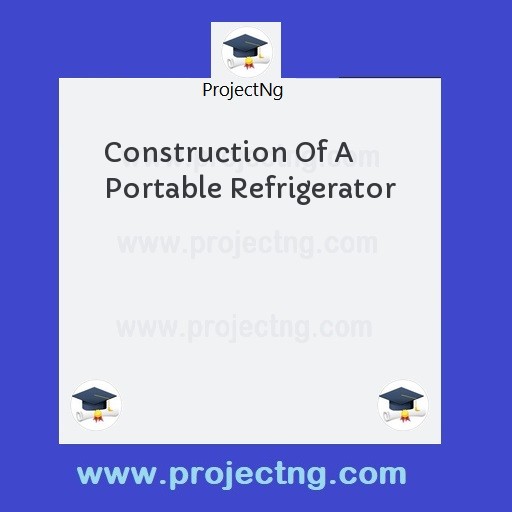Construction Of A Portable Refrigerator
Mechanical Engineering Project Topics
Get the Complete Project Materials Now! »
ABSTRACT
This project write up focuses on the construction and analysis of a portable cooling system with compressor capacity of 105W. The principles of improving the operation of a cooling system, choice of materials, various methods used in the construction and recommendation for advancement where duly treated. As the cooling system composes of mechanical and electrical parts, a lot of efforts were made to discuss the various stages and sequences of assembly. Stating a quite number of safety rules which must be adhered strictly by anybody who may embark on the project in future to achieve a satisfying result. With due consideration that we are in the modern age of refrigeration due to the gradual destruction of the ozone layer, refrigerant R134a (1,1,1,2-tetraflouroethane) was used . The entire system was tested and the condenser and evaporator temperature recorded 32oC and -4oC respectively. The results gotten from revealed that (i) the rate at which water cools in the system reduces as water reaches its freezing point (ii) the performance of the refrigerator is affected by the amount of load stored in it. The C.O.P (coefficient of performance) of the system was calculated and found to be high 6.33. Aprea et al (1996) reported that vapour compression refrigeration systems are widely used for cold storage, domestic and super market refrigeration because of its high coefficient of performance.
TABLE OF CONTENTS
TITLE- i
APPROVAL PAGE- ii
CERTIFICATION-- iii
DEDICATION-- iv
ACKNOWLEDGEMENT- v
ABSTRACT- vi
TABLE OF CONTENTS- vii
CHAPTER ONE- 1
1.0 INTRODUCTION-- 1
1.1 IMPORTANCE OF PROJECT- 2
1.2 NATURE OF THE STUDY-- 4
1.3 OBJECTIVE OF THE PROJECT- 5
1.4 SCOPE AND LIMITATION OF THE PROJECT- 5
CHAPTER TWO-- 6
LITERATURE REVIEW-- 6
2.1 HISTORY OF REFRIGERATION-- 6
2.2 THEORY OF REFRIGERATION CYCLE- 8
2.2 VAPOR-COMPRESSION REFRIGERATION-- 9
2.3 THE REVERSED CARNOT CYCLE- 13
2.4 CONDITION AT THE COMPRESSOR INLET- 17
2.5 SUB-COOLING OF THE CONDENSED VAPOUR- 18
CHAPTER THREE- 19
3.0 PRINCIPLE OF OPERATION-- 19
3.1 DESCRIPTION OF CONPONENTS- 19
3.2 SELECTION OF MATERIALS- 23
3.3 CONSTRUCTION METHODS AND PROCEDURES- 25
3.4 BILL OF ENGINEERING MEASUREMENT AND EVALUATION (BEME) 27
CHAPTER FOUR-- 28
DATA CALCULATION AND TESTING-- 28
4.0 TESTING-- 28
4.1 DATA COLLECTION-- 29
4.2 RESULT ANALYSIS- 31
4.2 COEFFICIENT OF PERFORMANCE (C.O.P) 32
CHAPTER FIVE- 36
SUMMARY, CONCLUSION AND RECOMMENDATION-- 36
5.1 SUMMARY-- 36
5.2 CONCLUSION-- 37
5.3 RECOMMENDATION FOR USE. 37
REFERENCES- 39
CHAPTER ONE
A portable refrigerator is simply a refrigerator fitted with rollers at its ends so that it can easily be moved to any direction with little application of force. Here, the mechanical refrigeration has to do with the production of a machine that controls a temperature lower than atmosphere temperature. This involves the removal of heat from a low temperature level and rejecting it to a relatively higher temperature level.
Naturally, heat flows from a body at a higher temperature to body at a lower temperature. But in the reverse case, an external energy or work input is required. The carrier substance used to transport heat is called a refrigerant. Therefore, refrigerator is the reversed heat engine cycle
Refrigeration is accomplished by various methods, such as: the vapour compression system, absorption system, and steam jet refrigeration cycle. In this project only the vapour compression system of refrigeration shall be discussed as it was the method adopted to accomplish the project.
Refrigeration contributes to the raising of standard of living of different races. Although refrigeration is primarily an application of thermodynamics, but advances have made refrigeration in recent years to grow into so many phrase where we need technicians, craft persons, engineers, scientists, and others from phases of engineering to pool skills and knowledge in the design, manufacturer and operation of the refrigeration system. A good knowledge of thermodynamics and properties of refrigerants is required before the complete cycle analysis can be made.
The application is limitless. The most common and readily recognized ones are found in the preservation of food and chilling of our drinks and water especially during the hot and dry season.
1.1 IMPORTANCE OF PROJECT
The importance attached to this project is to achieve a fast cooling system with little or no adverse effects on the food tissues, the flavor, freshness and natural nutrients of food materials. The construction intention is based on reduced cost, longer life span, fast freezing techniques, compactness, and portability and so on. We also employed the use of refrigerant that has no effect of man and his environment. However, the refrigerant that was used in this project does not enhance the ozone layer’s depletion.
While taking the specification on the size, we also put into consideration the items that are to be cooled or preserved. Also the cabinet dimensions and compressor capacity also considered.
The essential design parameters of the portable refrigerator
Be the First to Share On Social

Enjoying our content?
Don't miss out on new videos! Subscribe to our YouTube channel for more awesome content.
Subscribe Now!













